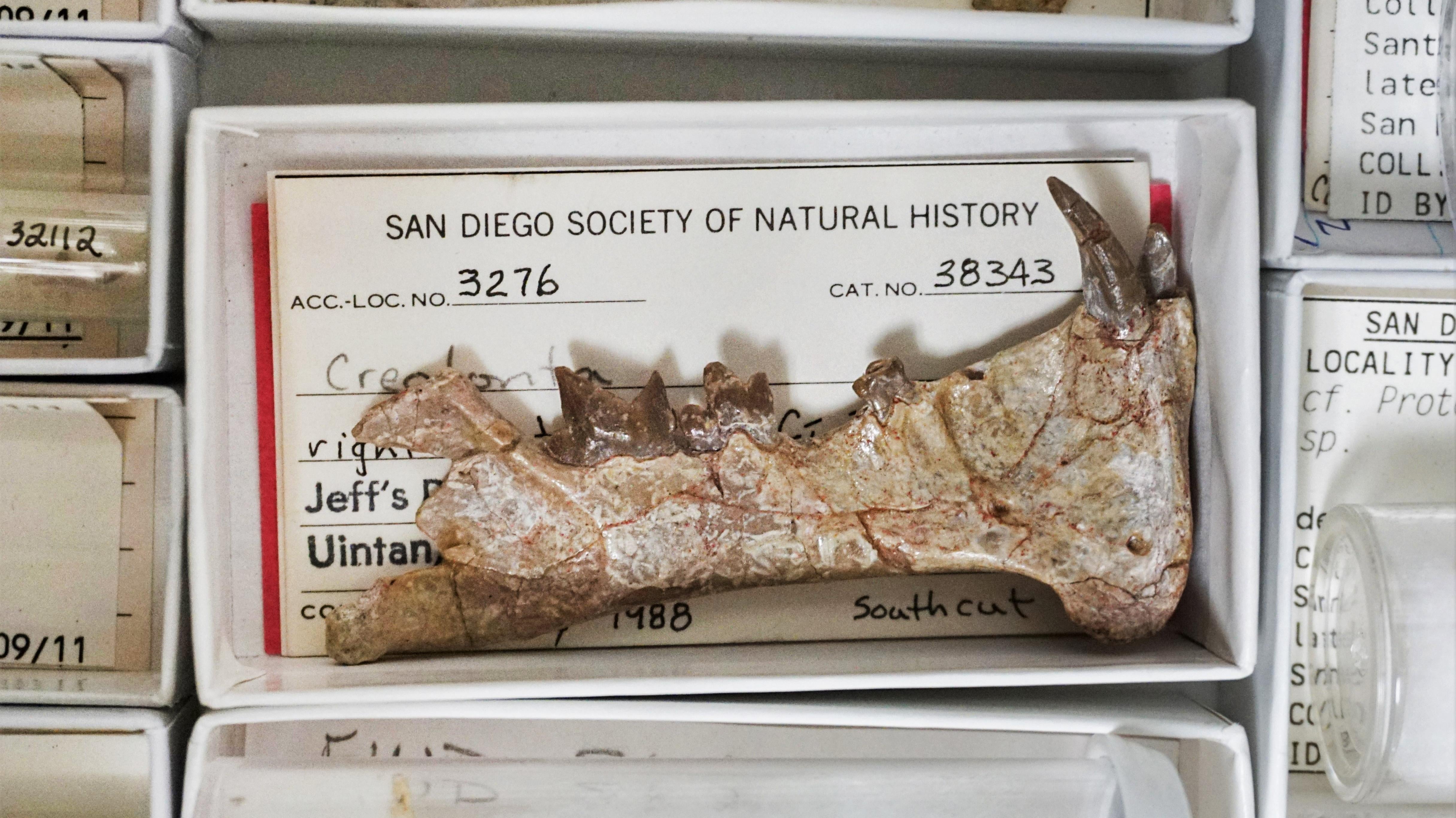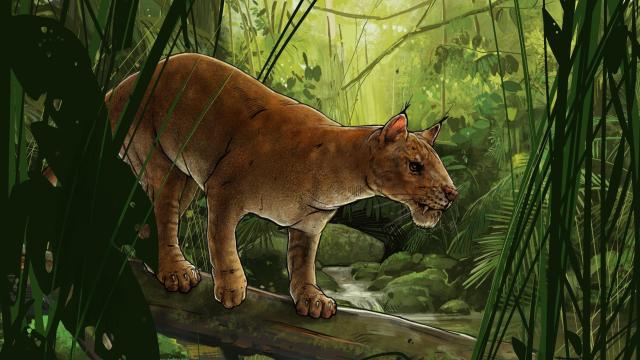Mammals with a nearly exclusive preference for meat are relatively common today, but new research uncovers one of the very first: a bobcat-sized carnivore that lived near what is now San Diego.
New research in PeerJ describes one of the earliest known mammalian obligate carnivores, a newly described species and genus designated Diegoaelurus vanvalkenburghae. This animal lived during the Eocene, and despite its very cat-like appearance, it wasn’t closely related to felines. Diegoaelurus was a machaeroidine — an extinct group of meat-eating mammals and the “oldest group of saber-toothed animals,” according to the paper, co-authored by paleontologist Ashley Poust from the San Diego Natural History Museum.
“It probably looked a lot like a small mountain lion, but stockier and with a bigger head,” explained Poust in an email. “Strangely, it wasn’t closely related to cats at all, so the similarities would have been convergent, arrived at separately as it evolved to be an efficient hunter.”
I like the term “obligate carnivores,” because it nicely describes these animals’ culinary lifestyle — they’re obligated to eat flesh, featuring diets that consist of at least 70% meat. Among living mammals, examples of hypercarnivores, as they’re also called, include polar bears, dolphins, lions, tigers, and even small cats. These animals tend to have strong facial muscles for holding prey and grinding bones and specialised teeth for piercing and shearing meat.
In a press release, Poust said that, 42 million years ago, “mammals were only just figuring out how to survive on meat alone,” and that the “one big advance was to evolve specialised teeth for slicing flesh — which is something we see in this newly described specimen.”

Paleontologists recovered a lower jaw and a jumble of well-preserved teeth from the 42-million-year-old Santiago Formation in San Diego County of southern California in 1988. The fossil, found during construction near Oceanside, was briefly studied and then housed at San Diego Natural History Museum.
The name Diegoaelurus vanvalkenburghae denotes the region in which the fossil was found and the scientist Blaire Van Valkenburgh, “in recognition of her substantial contributions to our understanding of iterative evolution in carnivorous mammals and saber-tooth paleoecology,” according to the paper.
The specimen is the first machaeroidine (pronounced mack-ay-roid-een) to be discovered along the U.S. West Coast or from any North American region outside of Utah and Wyoming. Machaeroidine fossils are relatively rare, hence the importance of this discovery. The specimen is offering fresh insights into the behaviour, diet, and evolution of one of the world’s first mammalian hypercarnivores — a creature that emerged some 24 million years after all non-avian dinosaurs went extinct.
With the Diegoaelurus fossil, Poust and his colleagues were able to analyse the relationships of these early mammalian carnivores for the first time. Prior to this study, scientists weren’t sure if multiple members of machaeroidines lived at the same time. A large member of this group, Apataelurus, lived in what is now eastern Utah at roughly the same time, so it’s entirely possible that they did.
“One of the most exciting things to come from our study is finding out that these early saber-toothed animals were more diverse than we thought, with more than one species alive at a time,” Poust told me. “It also tells us more about a really interesting time in North American history, when big subtropical rainforests extended into the southwestern United States.”
Shawn Zack, a paleontologist from the University of Arizona and a co-author of the paper, said in a press release that the new specimen “raises the possibility that there may be more out there to find.”
Analysis of the Diegoaelurus fossil suggests the creature had a pronounced downturned chin characteristic of saber-toothed mammals. It was also physically different enough from Apataelurus to warrant the creation of a new genus. Diegoaelurus was an early example of a cat-like carnivore, with its saber teeth up front and slicing scissor-like carnassials at the back. Fascinatingly, several animal groups independently acquired this adaptation in the millions of years after this species disappeared.
Its introduction represented a deadly new addition to the Eocene landscape, as nothing quite like it had appeared before. Back then, San Diego was forested and wet, featuring tiny rhinos, early tapirs, sheep-like oreodonts, rodents, primates, and marsupials. For Diegoaelurus, there was plenty of food to choose from.
“Big changes in the history of life are exciting because they give us insight into how evolution works, insight into how we got here,” Poust said. “Evolving to eat an all-meat diet is a big change and requires some very specialised equipment, sharp claws, and blade-like teeth. Our new fossil is a saber-toothed predator, which is even more specialised than other carnivores.”
Saber teeth evolved several times independently, yet no living mammal features this dental toolkit today, Poust noted. Diegoaelurus is therefore an exciting discovery, he said, because “it is one of very few fossils of the first mammal group to evolve saber-teeth, tens of millions of years before the more familiar saber-tooth cats.”
Intriguingly, Diegoaelurus may have lived at the same time as another saber-toothed mammal, the North American nimravids, also known as saber-toothed false cats. The two groups may have crossed paths, possibly competing for territory and prey. “There is at least a potential for competition with early nimravids to have contributed to the extinction of machaeroidines,” the study authors speculate. “As with many other topics involving machaeroidine paleobiology and evolution, the limited fossil record of the group precludes confident conclusions.”
Indeed, more fossil evidence will be needed to suss this out and to fully understand the evolutionary history of machaeroidines — including why they eventually died out. The search for more fossils continues.
Editor’s Note: Release dates within this article are based in the U.S., but will be updated with local Australian dates as soon as we know more.
